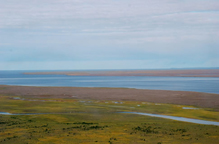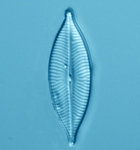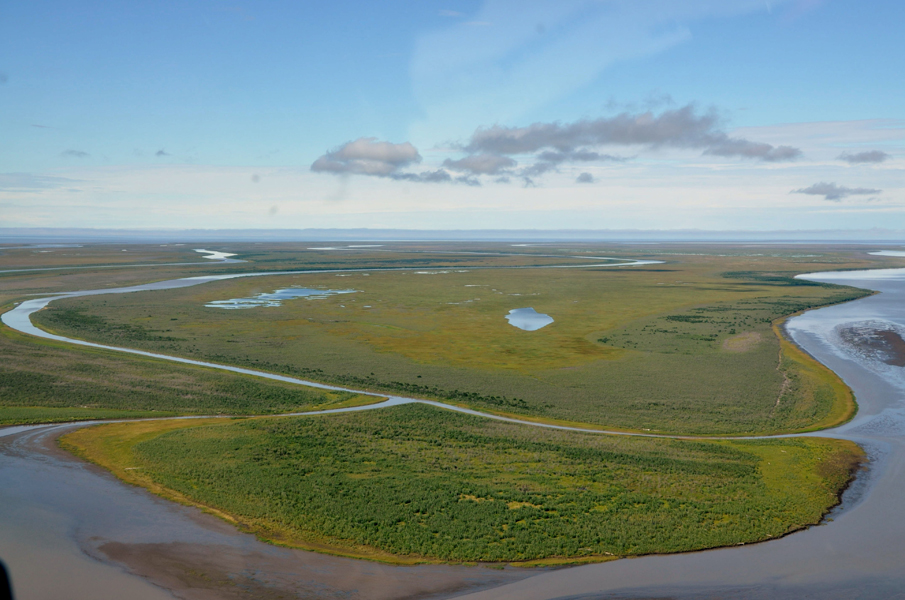 |
 |
|
|
The Mackenzie Delta. Canada's largest Arctic delta is dominated by freshwater lakes and channels. Image courtesy of Joshua Thienpont (Queen's University). |
Dead vegetation in the outer Mackenzie Delta. The 1999 saltwater intrusion resulted in widespread death of vegetation (brown area at rear of photo along channel) across the outer NW Mackenzie Delta. Over 10 years later, little to no recovery has occurred. Image courtesy of Joshua Thienpont (Queen's University). |
Brackish (saline) diatom species Navicula salinarum. Increases in Navicula salinarum at the time of the storm surge show that the lake went from a fresh to a saline-water system. Note, highly magnified microscope image, over 3000 would fit spread out on the head of a pin. Image courtesy of Joshua Thienpont (Queen's University). |
 |
||
|
Dead alder shrubs. Observed from the ground, nearly all shrubs of alder were killed by the 1999 storm surge. As the soil remains very salty a decade later, replacement by new species has not occurred. Images courtesy of Trevor Lantz (University of Victoria). |
Sampling dead vegetation. A team of researchers conducting vegetation surveys in the impacted zone of the 1999 storm surge. Massive mortality of vegetation following the event can be observed over much of the NW Mackenzie Delta. Images courtesy of Trevor Lantz (University of Victoria). |
Drilling through winter ice. The winter ice provides a stable platform for retrieving longer sediment sequences, such as those analyzed in our study. The first step is drilling through the nearly 2 meters of ice sealing the lake. For more detailed information on paleolimnological methods. click here. Image courtesy of Michael Pisaric (Carleton University). |
 |
||
| Unimpacted Mackenzie Delta. In contrast to the widespread loss of vegetation resulting from the storm surge, the Mackenzie Delta is generally a landscape of healthy, green vegetation. Image courtesy of Trevor Lantz (University of Victoria). | Alder tree rings. Analyses of growth rings from alder shrubs showed growth declines related to several known storm surges in the past, and widespread death following the recent 1999 storm surge. Image courtesy of Michael Pisaric (Carleton University). | Collecting a sediment core. The removal of a 7.6 cm (3") diameter, 22 cm core from a lake in the Mackenzie Delta is carried out from a small raft, with the area accessed by helicopter. Image courtesy of Joshua Thienpont (Queen's University). |
| Dead vegetation from air. The stark contrast between the dead vegetation killed by the 1999 storm surge, and vegetation along the edges of waterways that receives regular freshwater (and thus survived the damage), is visible from a circling helicopter. Image courtesy of Trevor Lantz (University of Victoria). | Small
ponds impacted by storm surge. With tens of thousands of lakes
throughout the Mackenzie Delta, many freshwater systems were
potentially impacted by the 1999 storm surge. These small ponds are
surrounded by dead vegetation, like most of the NW portion of the outer
delta. Image courtesy of Trevor Lantz (University of Victoria). |
Diatom
algae. Diatom algae are excellent indicators of changes in
salinity. The two small oval species are characteristic of freshwater,
while the larger elliptical specimens are saline species. Note, highly magnified
microscope image. Image
courtesy of Joshua Thienpont (Queen's University). |
| Lake under cover of winter ice. The cold, harsh winter ice is the most suitable platform for obtaining sediment cores, as lakes can be accessed directly by helicopter. One of the problems can be determining what is lake ice and what is land, as the lack of trees results in very little relief. Image courtesy of Joshua Thienpont (Queen's University). | Dead
vegetation
around Lake DZO-29. The shoreline of our main study lake shows the
extent of the vegetation death resulting from the storm surge and
flooding by saltwater in 1999. More than a decade after the event, no recovery
of these terrestrial or aquatic systems has occurred, raising the
question of how long (if ever) it will take to return to pre-impact
conditions. Image courtesy of Joshua Thienpont (Queen's University). |
Diatom
Craticula halophila.
The increase in this diatom species found primarily in more saline
waters following the 1999 storm surge shows the impact the event had on
the lake ecology of this system in the outer Mackenzie Delta. Note, highly
magnified microscope image. Image
courtesy of Holly Nesbitt (Queen's University). |

|